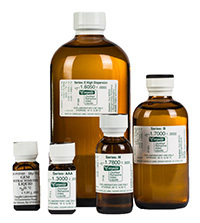Refractive Index Liquids
May 20th 2024
What are Refractive Index Liquids?
Refractive index liquids are liquids that have been formulated with a very precise refractive index. A droplet of refractive index liquid is used to identify fragments such as ores, minerals, gems, chemicals, particle fragments, and plastic particles using microscope immersion techniques.
Where are Refractive Index Liquids Used?
Refractive index liquids were originally used in the mineral field where refractive index liquids were used to identify and examine different kinds of minerals. Refractive index liquids are required tools in many labs including the fields of medicine, identifying asbestos particles, forensics, engineering, gemology, researching cancer, biology, optical analysis, and quality control.
What are Examples of Refractive Index Liquid Applications?
 Identifying Pollution - Refractive index liquids are used to Identify pollution particulates in water or air.
Identifying Pollution - Refractive index liquids are used to Identify pollution particulates in water or air.
Microfluidics - Using refractive index liquids to examine fluid flow patterns.
Spectrophotometry - Find the sample's refractive index by referring to calibration curves relating refraction index to wave length.
Strain Analysis - Using polariscopic immersion techniques, examine stress and strain effects of transparent and translucent items; molded, formed, curved, or intrinsically shaped parts.
Asbestos Particle Identification - Asbestos is often identified with refractive index liquids from series B and series E. An Asbestos High Dispersion Liquid Set includes the six most commonly used refractive index liquids in the field of asbestos particle identification.
Optical Analysis - Solids are studied microscopically with dispersion staining, focal masking, and double variation refractometry techniques with high dispersion liquids.
Gem Identification - Refractive index liquid 1.81 is critical in gem identification.
Refractometry - Calibrate refractometers and other special instruments.
Identify Minerals and Ores - Refractive index liquids are used with a microscope to Identify minerals and ores.
Toxemia - Refractive index liquids are used to assess the relative concentrations of sodium and potassium chloride in bodily fluids to find precipitated salts that indicate toxemia.
Fiber Optics - Fiber optic connections as well as mode stripping are performed with refractive index liquids.
Identify Chemicals and Plastics - Using a microscope and refractive index liquids helps identify chemicals and plastics.
Optical Coupling - Optical elements can be coupled with refractive index liquids formulated for refractive index and viscosity.
Education - Principles and applications of refraction can be demonstrated and taught using refractive index liquids.
Optical Lenses - By filling with liquids with a refractive index, hollow lenses can acquire special optical properties.
Identify Specimen Fragments, Translucent or Transparent Solids - A microscope is used along with refractive index liquids to identify specimen fragments, or translucent or transparent solids.
Refractive Indices Available in Refractive Index Liquids
To compute dispersion, three wavelengths are read for Standard Refractive Index Liquids Series AAA through M and High Dispersion Series E, and the liquids are blended so that the dispersion always falls into a consistent range. These liquids are quality-controlled for dispersion and index.
Cargille refractive indices are stated for Refractive Index Liquids at 25ºC, illuminated by 589.3 nms / 5893 angstroms Sodium light. The three certified series of refractive index liquids (AA, A, B) cover the span of most glasses, chemicals, minerals, and almost all biological materials.
| Refractive Index Series | Refractive Index Range | # Available Liquids | Description / Notes |
| Series AAA | 1.300 - 1.395 | 20 Different Liquids | Slightly volatile, colorless chlorofluorcarbon formulation. Keep tightly capped. |
| Series AA (Certified) | 1.400 - 1.458 | 30 Different Liquids | Very stable, colorless. |
| Series A (Certified) | 1.460 - 1.640 | 91 Different Liquids | Stable, colorless at the low end, increasing to faint yellow in bulk at the high end, colorless in thin layer. |
| Series B (Certified) | 1.642 - 1.700 | 30 Different Liquids | Stability inversely related to increasing index. Color increases with index to yellow or yellow brown in bulk, colorless in thin layer. |
| Series M | 1.705 - 1.800 | 20 Different Liquids | Methylene Iodide formulation, keep tightly capped. 1.740 - 1.780 liquids contain sulfur imparting yellow color in bulk. 1.785 - 1.800 liquids have tin iodide added, dark red color in bulk as methylene iodide evaporates. 1.705 - 1.735 liquids decrease in index. 1.740 liquids and up increase in index and may form crystals. All optical liquids virtually colorless in thin layer. |
| Series E (High Dispersion) | 1.500 - 1.640 | 29 Different Liquids | Slightly volatile, keep tightly capped. Supplied with optical constants for F, D, and C lines. Recommended by prominent microscopists who have developed and publishes these techniques. |
| Gem Refractometer Liquid | 1.81 | 1 Liquid | Stable. Golden yellow liquid. Store in dark for color stabilization. |




